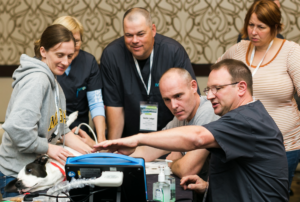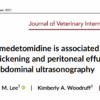

I was recently emailed by a colleague…
How do I break the habit of “Flashing” or “selective POCUS” and become disciplined to do AFAST®, TFAST® and Vet BLUE® which is Global FAST®?
The advantage of doing Global FAST® is that it avoids image interpretation errors of:
• Satisfaction of Search Error – a very common error in imaging. We have all made it. Stopping at the first major abnormality and then not continuing the rest of the interpretation.
• Confirmation Bias Error – a very common error in imaging by picking and choosing what to image based on what you believe the top differential is.
• Both errors are very problematic with the veterinary POCUS movement. My colleagues will realize this in time.
By doing Global FAST® you have acquired an unbiased set of data imaging points, 15-views of the abdomen and thorax including heart and lung, making Global FAST® a unique ultrasound approach.
Examples of common image interpretation errors would include my “sort-of” top 3 because as you do Global FAST® on every patient, you will understand what I mean, as there are endless clinical examples:
• Targeting the gallbladder in an acutely collapsed dog, finding gallbladder wall edema, and assessing the patient as being anaphylactic while missing the pericardial effusion because you never looked at the heart and characterize the caudal vena cava. Treatment is misguided and erroneous and risks morbidity and death.
• Performing a focused cardiac ultrasound and finding volume depletion, followed by fluid resuscitation, but failing to look for the source of the volume loss and missing the patient is hemorrhaging in its abdominal cavity. Treatment is misguided and erroneous and risks morbidity and death.
• Detecting pleural effusion in a cat and not recognizing its pericardial effusion that brings congestive heart failure, a treatable disease, to the top of the differential list (and seeing an enlarged left atrium on captured echocardiography views). The presentation to the client is one of a treatable disease and optimism based on the combination of findings.
A FASTVet pearl imaging pearl in critical patients is capture your cine (video) images and review them when the patient is placed in oxygen post-initial treatment.
So, how do you stay disciplined preventing the trap of “Flashing” or “Selective POCUS”?
1) Perform AFAST®, TFAST®, and Vet BLUE® the same way every time as often as possible so that you stay in task.
2) Follow our Goal-directed Templates (GDTs). We have 2 major versions that cover the presentation of the great majority of your patients:
a. The Standing Global FAST® Blend – LINK.
b. Right lateral Global FAST® Blend.
*We call these 2 major formats the Global FAST® Blend because it is more efficient to work on the side you have patient access rather than compartmentalizing AFAST®, TFAST® and Vet BLUE®.
So, how do you remember what you imaged?
c. SAVE images at each view by setting up your machine to prospectively capture 6-8 seconds cine (video) clips that may be reviewed.
d. Write your Global FAST® findings on the stainless-steel tabletop with a sharpie or an erasable marker.
e. Then take a picture with your Global FAST® findings plus the patient with your smart phone so you have the data to enter once you return to the electronic medical record.
f. Then wipe off with the marker with an alcohol cotton ball or paper towel.OR
g. Use a clip board parked on your ultrasound stand with paper Goal-directed Templates (GDTs) to write your findings immediately after your exam to later input into the patient medical record.
*We have GDTs on our FASTVet website Free Resources category under Premium Membership resources that may be used to develop recording templates that best work for your practice. We have attached a LINK for you to get AFAST®, TFAST® and Vet BLUE® to create your own Global FAST Blend:
Some Clinical Pearls if you have the time to continue reading:
Clinical Pearl #1: In critical patients the most important information is gained through Vet BLUE® and TFAST®.
• Blend Vet BLUE® and TFAST® including the Diaphragmatico-Hepatic (DH) View and do AFAST® later. You still will be able to screen for ascites through the DH View and get an impression of volume status characterizing the caudal vena cava and hepatic veins.
• If you have a choice, make it habitually to start in standing or sternal patients with the LEFT Vet BLUE® to the TFAST® Slide along the Hammerhead View, then move to the DH View from the LEFT side. With experience you can usually take another 60 seconds to complete the rest of AFAST® followed by the Focused Spleen.
• Then move to the RIGHT side of the patient and do the RIGHT Vet BLUE® followed by the TFAST® echocardiography views and then ending with the final HR5th Bonus View having the right kidney and right liver as its target organs.
Clinical Pearl #2: Set up your machine to SAVE 6-8 second PROSPECTIVE clips.
• At each view perform an unrecorded “pilot” to see what is at the view, THEN tweak the image with depth, gain, frequency, and the focus cursor as needed. NOW, repeat the view and RECORD your 6-8 second cine clip. You will get used to that time restriction and learn how to get all the image you want included within that time frame.
Clinical Pearl #3: Labelling images. No need to label.
• Perform Global FAST® in the same order as often as possible.
• AFAST® – Mark each AFAST® View with its respective AFAST® target organs, THEN you don’t need to label.
• TFAST® – The heart’s appearance if imaged in its entirety by having to see the depth in the far field marks what pericardial site view, hemithorax, you are imaging from because the Hammerhead, Smiley Face views are from the LEFT and the left ventricular short-axis mushroom view and log-axis views are from the RIGHT and each looks radically different. If you cut off the heart with too little depth, THEN the heart is more difficult to identify and heart chambers are mistaken for pleural and pericardial effusion and even its anatomical features mistaken soft tissue abnormalities.
• Vet BLUE® – Mark each view with its unique feature as follows:
1) Caudodorsal (Cd) view – The “Curtain Sign” (transition zone) that will be on the right of the screen.
2) Perihilar (Ph) view – Nothing but intercostal spaces
3) Middle (Md) view – Heart
4) Cranial (Cr) view – Soft tissue thoracic inlet (transition zone) that will be on the left of the screen
Final Comments:
• You should be able to complete Global FAST® within 5-7 minutes by your standardized blended Global FAST® approach especially in standing position.
• Review our FASTVet Webinars for other pointers and different ways to learn to integrate patient information most efficiently for a correct assessment.




